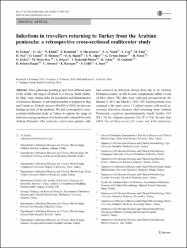| dc.contributor.author | Erdem, H. | |
| dc.contributor.author | Ak, O. | |
| dc.contributor.author | Elaldi, N. | |
| dc.contributor.author | Demirdal, T. | |
| dc.contributor.author | Hargreaves, S. | |
| dc.contributor.author | Nemli, S. A. | |
| dc.contributor.author | Inan, A. | |
| dc.contributor.author | Sözen, Hamdi | |
| dc.date.accessioned | 2020-11-20T15:02:23Z | |
| dc.date.available | 2020-11-20T15:02:23Z | |
| dc.date.issued | 2016 | |
| dc.identifier.issn | 0934-9723 | |
| dc.identifier.issn | 1435-4373 | |
| dc.identifier.uri | https://doi.org/10.1007/s10096-016-2614-z | |
| dc.identifier.uri | https://hdl.handle.net/20.500.12809/2485 | |
| dc.description | WOS: 000377022000004 | en_US |
| dc.description | PubMed ID: 26964538 | en_US |
| dc.description.abstract | Mass gatherings pooling people from different parts of the world-the largest of which is to Mecca, Saudi Arabia, for Hajj-may impose risks for acquisition and dissemination of infectious diseases. A substantial number of pilgrims to Hajj and Umrah are Turkish citizens (456,000 in 2014) but data are lacking on scale of the problem. We did a retrospective cross-sectional multicenter study in Turkey to explore the range of infections among inpatients who had recently returned from the Arabian Peninsula. Our inclusion criteria were patients who had acquired an infection during their trip to an Arabian Peninsula country, or who became symptomatic within 1 week of their return. The data were collected retrospectively for January 1, 2013 and March 1, 2015. 185 Turkish patients were recruited to the study across 15 referral centers with travel associated infectious diseases after returning from Arabian Peninsula countries (predominantly Saudi Arabia 163 [88.1 %] for religious purposes 162 [87.5 %]). Seventy four (40.0 %) of them were a parts per thousand yen 65 years old with numerous comorbidities including diabetes (24.3 %) and COPD (14.1 %). The most common clinical diagnosis was respiratory tract infections (169 [91.5 %]), followed by diarrheal diseases (13 [7 %]), and there was one case of MERS-CoV. Patients spent a median of 5 (3-7) days as hospital inpatients and overall mortality was 1.1 %. Returning travellers from the Arabian Peninsula present as inpatients with a broad range of infectious diseases similar to common community acquired infections frequently seen in daily medical practices in Turkey. | en_US |
| dc.item-language.iso | eng | en_US |
| dc.publisher | Springer | en_US |
| dc.item-rights | info:eu-repo/semantics/openAccess | en_US |
| dc.title | Infections in travellers returning to Turkey from the Arabian peninsula: a retrospective cross-sectional multicenter study | en_US |
| dc.item-type | article | en_US |
| dc.contributor.department | MÜ, Eğitim ve Araştırma Hastanesi | en_US |
| dc.contributor.institutionauthor | Sözen, Hamdi | |
| dc.identifier.doi | 10.1007/s10096-016-2614-z | |
| dc.identifier.volume | 35 | en_US |
| dc.identifier.issue | 6 | en_US |
| dc.identifier.startpage | 903 | en_US |
| dc.identifier.endpage | 910 | en_US |
| dc.relation.journal | European Journal of Clinical Microbiology & Infectious Diseases | en_US |
| dc.relation.publicationcategory | Makale - Uluslararası Hakemli Dergi - Kurum Öğretim Elemanı | en_US |


















